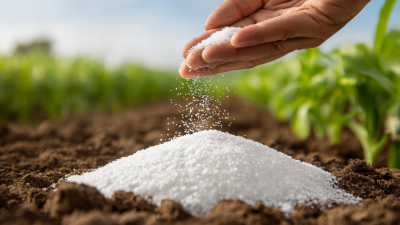In recent years, the agricultural industry has witnessed a significant shift towards maximizing crop yields through the use of advanced fertilizers. One such innovation is Water Soluble Phosphatic Fertilizers, which have been shown to enhance nutrient uptake efficiency and improve plant growth. According to a report by the Food and Agriculture Organization (FAO), global crop yields must increase by 70% by 2050 to meet the demands of a growing population, underscoring the urgent need for effective fertilization strategies.

Additionally, research from the International Fertilizer Association (IFA) indicates that phosphorus is a critical nutrient, with over 40% of the world's agricultural soils being deficient in this vital element. By integrating Water Soluble Phosphatic Fertilizers into their nutrient management practices, farmers can optimize plant health and productivity while addressing the looming food security challenge. This blog will explore practical approaches to leverage these fertilizers for maximum yield potential.
Water-soluble phosphatic fertilizers play a crucial role in modern agriculture, significantly impacting crop yields and soil health. Unlike traditional fertilizers, these water-soluble options provide phosphorus in a readily available form, allowing plants to absorb it efficiently. According to a report by the International Fertilizer Association, phosphorus is essential for photosynthesis and energy transfer in plants, making it a vital nutrient for high-yield crops. Studies indicate that using water-soluble phosphatic fertilizers can increase crop yields by up to 30%, particularly in phosphorus-deficient soils.
To maximize the benefits of water-soluble phosphatic fertilizers, farmers should consider applying them during critical growth stages of crops. For instance, applying these fertilizers during the early stages of plant development can significantly enhance root growth and overall vigor. Additionally, utilizing a precision application method can reduce nutrient runoff, ensuring that more phosphorus is used by the plants and less is wasted.
Another tip is to integrate water-soluble phosphatic fertilizers with irrigation systems. This approach not only improves the efficiency of nutrient uptake but also reduces the risk of nutrient leaching into groundwater. Research shows that when these fertilizers are applied through drip irrigation systems, agricultural producers can see a remarkable improvement in crop performance and soil fertility.
Water soluble phosphatic fertilizers play a crucial role in optimizing crop yields by providing essential nutrients in highly available forms. One prominent benefit is their rapid uptake by plants, which can lead to significant increases in productivity. A recent industry report highlights that the global market for water soluble fertilizers is expanding, driven by the increasing demand for efficient nutrient delivery systems in agriculture. These fertilizers contribute to precise nutrient management, enhancing soil fertility and crop performance, aligning with the trends observed in sustainable farming practices.

Additionally, the adoption of water soluble phosphatic fertilizers can improve nutrient efficiency, minimizing the risk of nutrient leaching and losses that are prevalent with traditional fertilizers. According to a recent study, integrating these fertilizers into farming practices can lead to up to a 30% increase in nutrient use efficiency. Technologies such as UAV-based spectrum sensing are coming into play, providing farmers with advanced tools to monitor nutrient levels and optimize their application. This innovation not only supports higher yields but also promotes sustainable agriculture by reducing environmental impacts, thus addressing the pressing challenges facing modern food production systems.
Water soluble phosphatic fertilizers play a crucial role in enhancing crop yields by ensuring that plants receive essential nutrients in a readily absorbable form. To maximize the benefits of these fertilizers, employing the right application techniques is key. Here are the top three techniques for optimal nutrient absorption.
Firstly, fertigation is an effective method that combines fertilization and irrigation. By dissolving water soluble phosphatic fertilizers in irrigation water, plants can receive nutrients directly through their root systems. This method not only enhances nutrient uptake but also reduces the risk of nutrient runoff.
Secondly, foliar application is another technique worth considering. By spraying a diluted solution of water soluble phosphatic fertilizers directly onto the leaves, nutrients can be absorbed quickly. This method is especially useful during critical growth phases when plants require an additional nutrient boost, such as during flowering or fruiting.
Lastly, incorporating these fertilizers into the soil before planting can set a strong foundation for crop growth. When applied at the right time, they can improve the availability of phosphorus to the developing root system. It is essential to conduct soil tests to determine the appropriate amount and timing for application, ensuring that plants receive the optimal nutrient levels during their growth cycle.
When it comes to enhancing crop yields, selecting the right water-soluble phosphatic fertilizer is crucial. Phosphorus is essential for plant energy transfer, root development, and flowering. According to the Fertilizer Institute, using water-soluble phosphatic fertilizers can increase nutrient uptake by crops by up to 30%, resulting in significantly improved yields. However, not all fertilizers are created equal, so it's essential to consider several factors when making your choice.
Firstly, analyzing the nutrient ratio is important. A balanced N-P-K (Nitrogen-Phosphorus-Potassium) ratio tailored to your crop's needs can optimize growth. Research from the International Plant Nutrition Institute (IPNI) suggests that crops like corn benefit from a fertilizer with a higher phosphorus content during critical growth phases, ensuring maximum nutrient availability. Furthermore, consider the solubility of the fertilizer; highly soluble products allow for quicker absorption by plants, facilitating better utilization during growth.
Lastly, environmental conditions play a pivotal role in fertilizer selection. Soil pH, temperature, and moisture levels affect nutrient availability. A report from the Soil Science Society of America indicates that utilizing the right water-soluble fertilizers can mitigate the risks associated with signaling nutrient deficiencies in various soil types, providing farmers with the confidence to maximize their yields sustainably.
This chart illustrates the effect of different types of water soluble phosphatic fertilizers on crop yields. The data is based on average yield increases measured in tons per hectare.
Phosphorus plays a crucial role in plant growth, influencing key processes such as energy transfer, photosynthesis, and nutrient transportation. This essential element is a vital component of ATP (adenosine triphosphate), which fuels various cellular activities. By enhancing root development and improving crop resilience against environmental stress, phosphorus directly contributes to higher yields and better crop quality.
To make the most of water soluble phosphatic fertilizers, consider applying them during critical growth stages, such as seedling establishment and flowering. This timing maximizes phosphorus uptake when plants need it most. Additionally, conducting soil tests can help determine phosphorus levels and ensure balanced fertilization, preventing deficiencies or excesses that could harm plant health.
Another tip is to combine phosphatic fertilizers with effective irrigation practices. Adequate moisture is essential for phosphorus mobility in the soil, ensuring that plants can efficiently absorb this vital nutrient. Implementing drip irrigation systems can further optimize water use and minimize nutrient loss, leading to healthier crops and increased yields.







